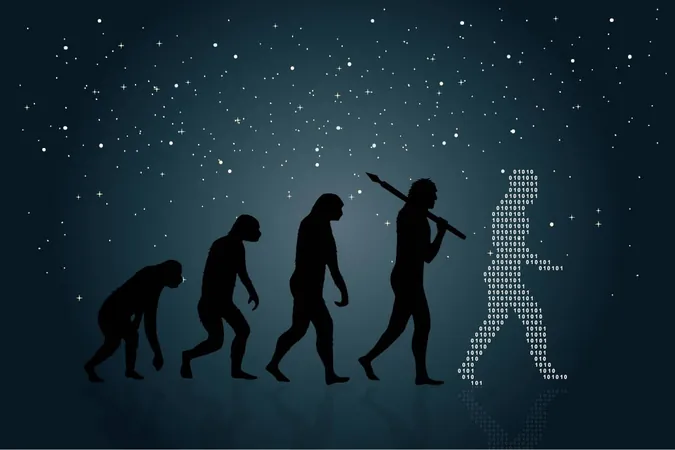
Groundbreaking Study Challenges Evolutionary Theory: Are We Misinterpreting Evolution?
2024-10-06
Groundbreaking Study Challenges Evolutionary Theory: Are We Misinterpreting Evolution?
A major shift is brewing in the realm of evolutionary biology as a new study brings fresh insights into a long-debated phenomenon — the perceived acceleration of evolution in younger species versus their older counterparts. For ages, the scientific community has grappled with significant gaps in the evidence supporting the Theory of Evolution, leading some to question its validity. However, a recent groundbreaking research paper may have illuminated one of the core misunderstandings in this complex field.
Traditionally, evolutionary biologists have observed that younger species appear to evolve at a faster pace compared to older species groups. This notion has fueled a myriad of hypotheses concerning why evolutionary rates for speciation and extinction seem heightened during certain time frames. Despite the longstanding consensus that younger clades evolve more rapidly, the authors of this new research claim that the perceived acceleration could merely be an illusion created by statistical "noise."
Published in *PLOS Computational Biology*, the paper titled “Noise Leads to the Perceived Increase in Evolutionary Rates Over Short Time Scales" was co-authored by Brian C. O'Meara from the University of Tennessee and Jeremy M. Beaulieu from the University of Arkansas. The researchers introduce a novel statistical framework that has the potential to debunk previously accepted ideas regarding evolutionary rates, suggesting that much of the evidence used to support rapid evolution is a misinterpretation arising from inherent data errors rather than straightforward biological realities.
The Myth of Hyperbolic Patterns in Evolution
The core of the debate centers on the hyperbolic pattern observed in evolutionary rates. Previous studies indicated that younger species, particularly those with recent common ancestors, demonstrate dramatically heightened evolutionary rates. This finding led to multiple theories, including rapid diversification in novel environments or the impact of catastrophic events like asteroids, which could similarly drive high rates of both extinction and speciation.
However, O'Meara and Beaulieu's study proposes that these explanations may have missed the mark. They attribute the erroneous perception of accelerated evolutionary rates to statistical noise, asserting that this noise skews data patterns and creates the misleading appearance of rapid evolution among younger species.
A Shift in Understanding Evolution
The implications of these findings are significant. If the appearance of an evolutionary speed-up is merely a statistical artifact, then many existing evolutionary models need re-evaluation. This revelation questions the assumption that evolution operates distinctly on short and long time scales, suggesting that the differences previously thought to exist may be less relevant than scientists have assumed.
The authors emphasize the importance of rigorous data analysis in evolutionary research. They state, “It's a common principle in science that the simplest possible explanation to fit the data is usually the right one.” Thus, if opposing theories could be resolved by recognizing inherent biases and noise in data, a clearer understanding of evolutionary dynamics could arise.
A Call for New Research Paradigms
While the results may disappoint some researchers who built hypotheses around accelerated evolutionary rates, they also pave the way for future studies by prompting a reevaluation of established norms and encouraging diverse, more precise models for investigating evolutionary rates.
This study serves as an essential reminder: scientific understanding is always evolving, particularly when revisited with advanced methodologies. By merging mathematics, statistics, and biology, O'Meara and Beaulieu are pushing the field towards a more accurate interpretation of evolution, urging researchers to be cautious of biases and noise that may skew our comprehension of nature's complexities.
As the academic community digests these findings, it signals a paradigm shift that could reshape our views on evolution. The potential for progress lies in learning from past assumptions and embracing new analytical tools, which may lead to groundbreaking discoveries in the biological sciences.
Conclusion
Is your understanding of evolution ready for a makeover? Stay tuned for more revelations that could change everything we thought we knew!



 Brasil (PT)
Brasil (PT)
 Canada (EN)
Canada (EN)
 Chile (ES)
Chile (ES)
 España (ES)
España (ES)
 France (FR)
France (FR)
 Hong Kong (EN)
Hong Kong (EN)
 Italia (IT)
Italia (IT)
 日本 (JA)
日本 (JA)
 Magyarország (HU)
Magyarország (HU)
 Norge (NO)
Norge (NO)
 Polska (PL)
Polska (PL)
 Schweiz (DE)
Schweiz (DE)
 Singapore (EN)
Singapore (EN)
 Sverige (SV)
Sverige (SV)
 Suomi (FI)
Suomi (FI)
 Türkiye (TR)
Türkiye (TR)